
The history of photography is over a century old — in fact, it was 107 years ago that Oskar Barnack created the Ur-Leica, a camera that would later be known as the genesis of the 36×24 “full-frame” format. Since then, hundreds of companies across the world have, to varying degrees of success, produced everything from 35mm to 127 to an assortment of medium format sizes and finally to digital.
Most of these endeavors are lost to history or never advanced beyond the prototype stage. Some of them were created for government and military use. Some were produced as limited or commemorative editions. I would estimate we have only a small fraction of photographic history available to us, even with the internet.
Because of this, it is virtually impossible to compile a truly accurate list of the “rarest cameras.” Realistically, however, such a list would just be a bunch of cameras that never made it to the market.
So, what we have tried to do — just as we did in our 9 of the Rarest Lenses You Can Actually Buy article — is write about some of history’s lesser-known and very unique cameras. By all definitions, all these cameras are extremely rare, despite several of them being quite accessible to prospective buyers.
With that said, we have selected nine of history’s rarest cameras:
Alpa Reflex I
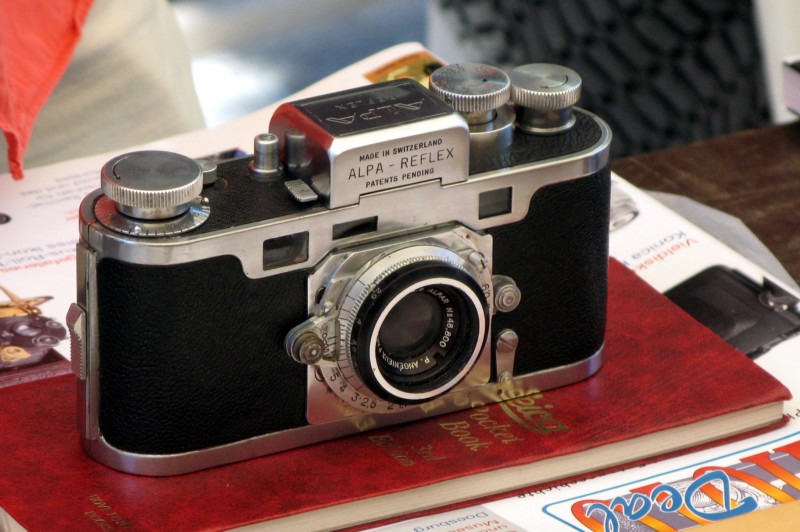
The Alpa name is one of the most storied in the history of photography. It all started with Yakov Bogopolsky, a Jewish Russian born in Kiev. In his youth, he relocated to Switzerland and changed his name to Jacques Bolsky. Bolsky studied mechanical engineering with a particular interest in motion picture film. Eventually making his foray into designing cameras, Bolsky created one of the most famous cinema cameras of all time — the 16mm Bolex H16.
In 1930, Bolsky sold his assets and patents to Paillard — who would continue producing Bolex cameras under the name Paillard-Bolex — and in 1935 he found himself under the employ of Pignons S.A., a Swiss watchmaking company. There he designed one of the first 35mm SLR cameras in history — a camera which would eventually become the Alpa-Reflex.
In 1939, Bolsky fled to the United States to escape the threat of neighboring Nazi Germany. Pignons, however, continued to persist with the Alpa-Reflex, though development was difficult — not only were they not a camera company, but Europe was at war. Finally, however, at the Swiss Trade Fair in 1944, Pignons unveiled the Alpa-Reflex I.
The Alpa Reflex Model I followed closely to the traditional and values of Swiss watchmaking — it was a precision device with the highest level of craftsmanship. Like the Ihagee Exakta cameras of the 1930s, the Alpa sported a waist-level viewfinder. But unlike any other camera, it also featured a rangefinder positioned on the left-hand side of the body like all other rangefinders. This makes it one of the only SLR cameras with a rangefinder ever made.
Most of the Alpa Reflex Model I bodies were sold with collapsible Angenuinex lenses — either a 50mm f/1.8 or a 50mm f/2.9. Eventually, Alpa cameras would be paired with the phenomenal (and highly collectible) Kern-Switar lenses.
Later models in the Alpa line would implement a 45 degree angled pentaprism viewfinder — along with the Rectaflex and Zeiss Ikon Contax S, these cameras finally allowed photographers to view a corrected image as the eye sees it. Prior to that, SLR designs would display a reversed image.
Only 571 Alpa Reflex Model I cameras were ever produced. The camera, like most of the Alpa line, is one of the most desired and collectible cameras in history.
Kodak DCS 100
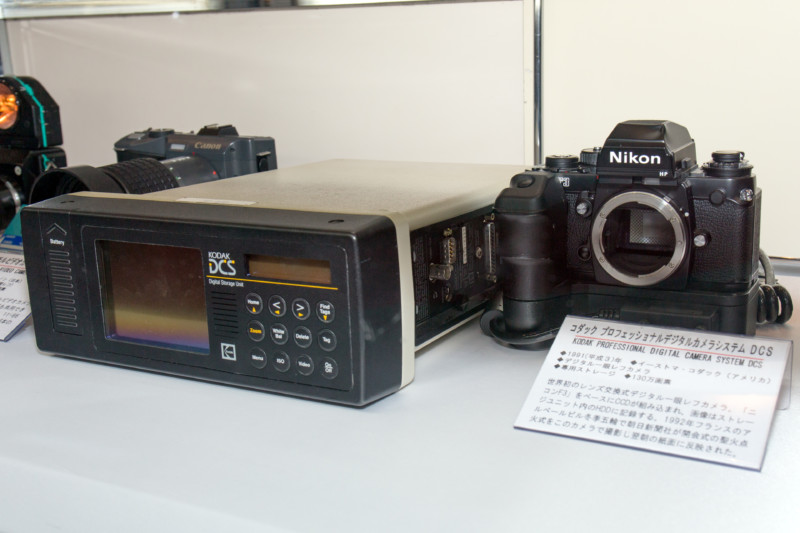
It’s rather well known that Kodak’s late history was fraught with issues stemming from the digital revolution, with many ascribing Kodak’s lack of initiative in the digital arena to their downfall. While this was certainly true in the 2000s, Kodak was actually one of the pioneers in consumer digital camera technology. In 1991, they released the first commercially available DSLR — the Kodak DCS 100.
The DCS 100 was a Nikon F3 body fitted with a 1.3-megapixel Kodak DC3 digital back. While that was the extent of the actual imaging system, the power and storage were a wholly different story. Given the state of digital storage technology in 1991, the DCS 100 had to store its images on an external unit. Kodak integrated the camera’s battery and a 3.5” SCSI hard drive into a tethered Digital Storage Unit (DSU). It had a 200MB capacity which was capable of storing 156 uncompressed images or 600 JPEG files. The DSU was so large and heavy it was designed to be worn around the photographer’s shoulders.
Available with either a standard color DC3 back or a monochrome back, the DCS 100 system retailed for $20,000 — equivalent to over $39,000 in 2021.
While the Kodak DCS system continued to evolve — ending with the 14MP Kodak DCS PRO SLR/n and SLR/c cameras in 2004 — only 987 units of the DCS 100 were ever produced.
Leica S1
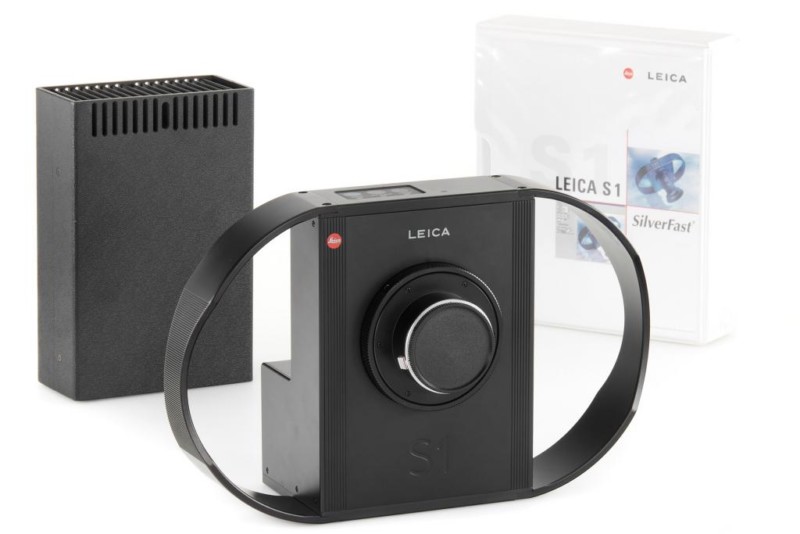
If you’ve heard of the Leica S medium format cameras, have you ever wondered why there was a Leica S2, followed by the very recently released Leica S3, but they did not seem to have a Leica S1? The answer is: they did. But most people have never heard about it, both because it is extremely rare but also because it was released in 1996 — basically at the genesis of the digital uprising. The Leica S2 was not released until twelve years later, at which point digital photography was not only mature but the industry standard.
There have been a lot of strange cameras with bizarre approaches to how they function and many with a design that is best described as no-holds-barred unique. The Leica S1 may take the crown for such a description. In fact, I don’t even know how to describe the appearance of this camera — even the single photo above does not do it justice because you need to see it from every angle to really appreciate it. I highly recommend a Google image search, especially because, in my opinion, the design is both functional and strange enough to be charming.
Leica has always (and to this day) taken flack for being behind in the digital imaging arena. That is not a claim without justification, but people who make that assertion ought to read up about the Leica S1.
Unveiled at Photokina in 1996, and available to the public near the end of 1997, the Leica S1 made headlines for two primary reasons: its 26.4-megapixel resolution and its medium format sensor. To put that in perspective, it was not until the 31.6-megapixel Phase One P30 back was released in 2004 that the S1’s resolution was surpassed. There were medium format backs with higher resolution prior to the S1, but they were only for 4×5 large format bodies. Even after the Phase One P30 was released, the Leica S1 still had the distinction of being the highest resolution fully integrated camera ever made — until the Leica S2 was released.
The S1’s medium format sensor was an odd 36×36 size — meaning it was 50% larger than full-frame spatially but with only a 17.7% longer diagonal. Both would produce the same horizontal field of view. Since it was a scanning camera, it took over three minutes to read out the entire sensor. Suffice to say, you weren’t using this to shoot the Superbowl.
Its image quality was absolutely stunning for its time. It housed a triple-linear CCD sensor with a base ISO of 50 and was highly regarded for its excellent color reproduction. Since it used a scanning sensor — and thus required no interpolation — it could capture full RGB color information at every photosite. The resulting 48-bit files clocked in at an enormous 150MB. Not only is that a hefty file in 2021, but it is also worth noting that the average home computer in 1996 only had a hard drive capacity of around 1,000MB (1GB).
With its low 50 base ISO, true RGB 48-bit files, massive 26.4MP resolution, large sensor, and about 11 stops of dynamic range, it was capable of results completely unheard of in 1996.
To top off the list of unique specifications, the camera had a user interchangeable lens mount. Options included Leica R and M, Canon FD, Contax C/Y, Minolta MD, Nikon F, Olympus OM, and Pentax K — basically every mainstream 35mm lens mount ever made. Because the sensor’s horizontal measurement was identical to 35mm film, the image circle of full-frame lenses could cover its 36x36mm sensor without any caveats or disadvantages.
Only 1,500 were ever produced, but according to most accounts, a mere 150 of those were sold.
Leica Digital Modul R (DMR)
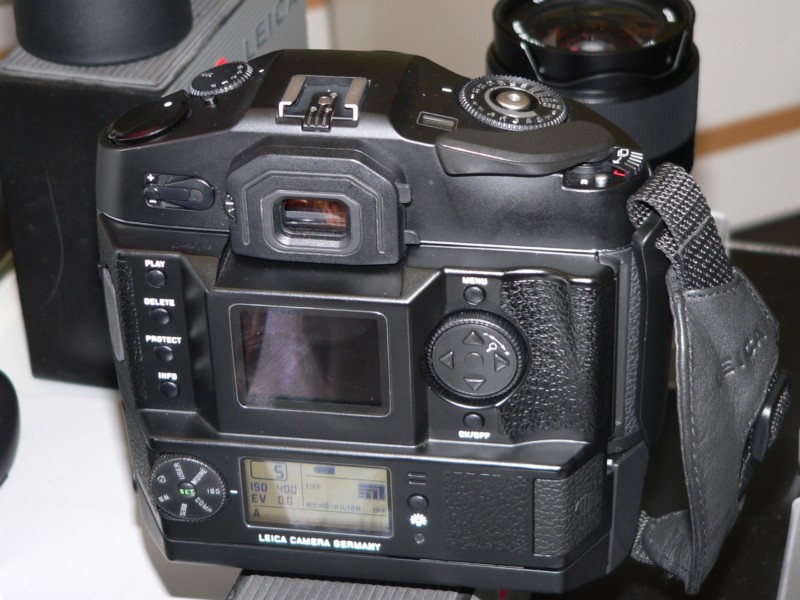
While Leica cemented its name in the history books with its rangefinder cameras, they did produce two SLR systems: the 35mm Leica R line, which started with the Leicaflex in 1964, and the Leica S2 and S3 medium format digital cameras. The R line of cameras moved from the Leicaflex family to the Leica R3 and ended with the Leica R9 in 2002.
In 2003, Leica announced the Digital Modul R (DMR), a module containing a 10-megapixel Kodak CCD sensor developed in concert with Imacon. The module clipped onto the back of either the Leica R8 or R9 — which were designed from the beginning to function with future digital solutions — and a power unit was attached to the base of the camera.
Because the Kodak-designed sensor had to be positioned precisely at the film gate it had to have a smaller area than the 36x24mm dimensions of film (or full-frame sensors). Thus, it had a 1.37x crop factor — slightly more than APS-H — with a sensitivity ranging from ISO 100 to ISO 800. An anti-aliasing filter was omitted from the sensor to increase resolving power.
The resulting digital camera was surprisingly smooth in its function and ergonomics. A small LCD on the rear was used for menu, playback, and all the typical settings we’re used to today. A smaller screen below the main LCD would display basic information — ISO setting, exposure compensation, battery level, white balance, etc. Exposure mode, shutter speeds, and exposure compensation were all set via the regular controls on the top of the body — just as they were when using the camera with film.
Naturally, the camera utilized Leica R lenses — compatibility was limited to 3-Cam, ROM, or earlier lenses that have been modified with the proper cams (or converted to ROM).
One fascinating feature that, as far as I know, is exclusive to this camera is its “audio histogram.” While there is a standard histogram on the rear screen, the camera could be set to emit an acoustic sound to alert the photographer of over or underexposure. This would allow the photographer to adjust accordingly without taking their eye away from the viewfinder.
The DMR was discontinued in 2007 after selling only 2,200 units. Leica planned to produce an all-digital Leica R10, but such plans never came to fruition. The Leica R8 and R9 with DMR remain the only hybrid film/digital 35mm cameras ever to be made.
Minox 35 GT-X
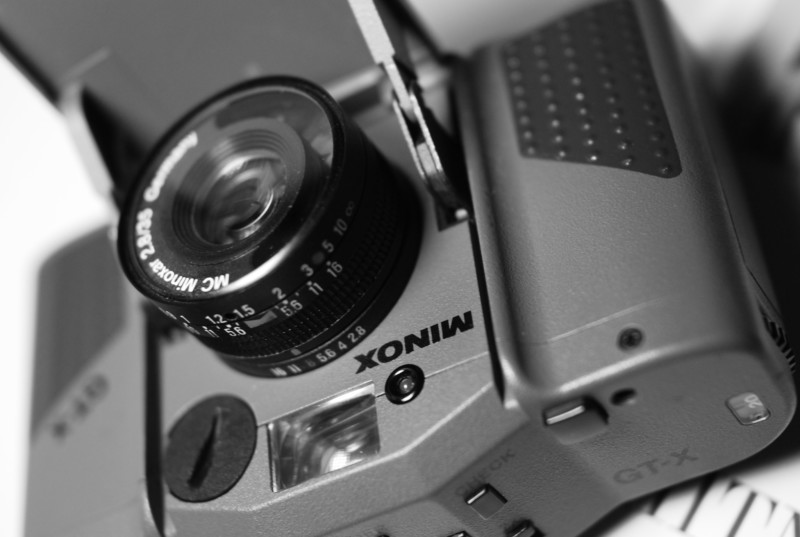
History gave us a plethora of 35mm compacts, ranging from bargain-basement consumer models to elegantly designed bodies fitted with preeminent optics. The Minox 35 line — despite its affordability and relative lack of popularity — is one of the true jewels of compact film photography.
Best known at the time — and to this day — as the smallest 35mm camera ever made, the Minox 35 bodies were barely thicker than a film canister and a mere four inches in length. This of course varied from model to model in minor ways, but its diminutive size and trademark hinged door remained consistent until the end.
First introduced in 1974 with the Minox 35 EL, there would be twenty more models over the years culminating with the Minox 35 GT-S in 1998, which marked the end of the Minox 35 line. The early models were fitted with a 35mm f/2.8 Color-Minotar lens with a Tessar design and four-bladed aperture — the final models moved to a newly designed MC Minoxar lens. The cameras were zone focus-only and a majority were limited strictly to aperture-priority exposure.
The Minox 35 GT-X is one of the last models produced. It featured the 35/2.8 MC Minoxar lens, aperture-priority, DX coding from ASA 25-3200, and is one of only several models with a “snapshot” setting on the lens — a green mark that quick-sets the camera into a hyperfocal f/8 mode.
Only 371 GT-X cameras were sold, making it the rarest of the entire Minox 35 line. Unlike every other rare camera here, you can easily find one of these on eBay for around $300-400. Perhaps not the GT-X model, but I highly recommend seeking out a Minox 35 camera — if not for their diminutive presence, then for the contrasty, beautiful rendering of the lenses. The Minox 35 GT or GL are readily available for under $100.
Nikon F2/T (F2 Titan)
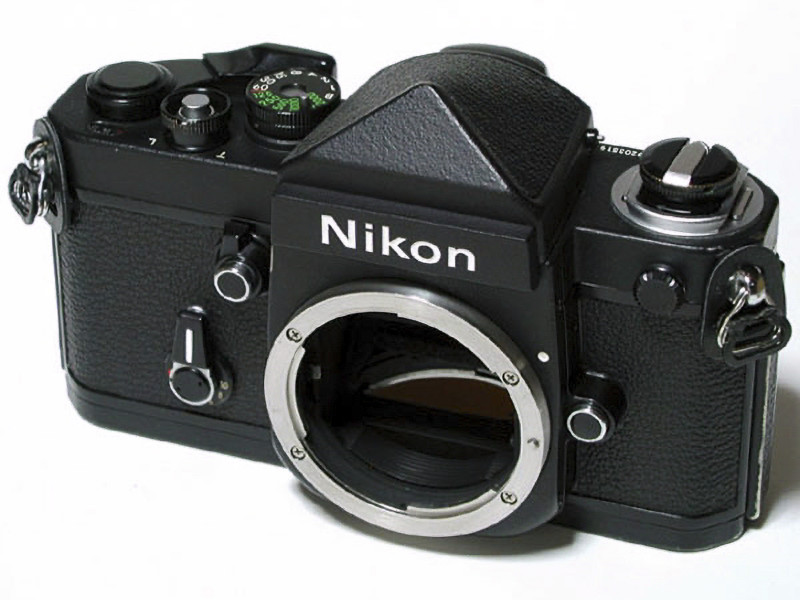
The Nikon F2 followed on the heels of the widely popular and highly influential Nikon F, which was first released in 1959. The F2 improved on the F in several very valuable ways: a faster 1/2000th shutter speed, a hinged swing-open back, an optional motor drive, a wide array of detachable finders (including metered heads), and general ergonomic improvements. The standard finder was the Nikon DE-1, which today is worth a pretty penny compared to other finders like the metered DP-1 finder.
In 1976, five years after the introduction of the F2, Nikon released one of the most dependable, rugged, and now collectible cameras in their history: the Nikon F2/T. Constructed with a titanium shutter, titanium-covered top and bottom plates, titanium-covered door and prism, the camera was built to withstand a level of abuse that no camera deserves. Even the lens mount was made of solid titanium.
Unlike the standard F2, or any other Nikons, the F2/T featured a tough-as-nails mottled-black paint with an attractive, stylish texture. There were a few models produced in a chrome finish, but I have never come across one in the wild nor on eBay.
There are three versions of the F2/T — the “regular” version with F2/T engraved on the top plate but without any other lettering, an identical version with “Titan” engraved on the front, and a modified high-speed version with a pellicle mirror and high-speed battery pack. The latter was capable of 10 frames per second.
The version with the “Titan” script on the front is generally more desirable than the one without the Titan nameplate, but both are equally rare. The high-speed model is not nearly as collectible or desirable as either of the others.
The exact total production of all versions is unknown but estimated to be 2,000 at most — those with the “Titan” nameplate numbering somewhere in the three digits. Easily one of my top three most desired cameras, you can pick one up fairly affordably — at least compared to most of the other cameras on this list.
Plaubel Makina W67
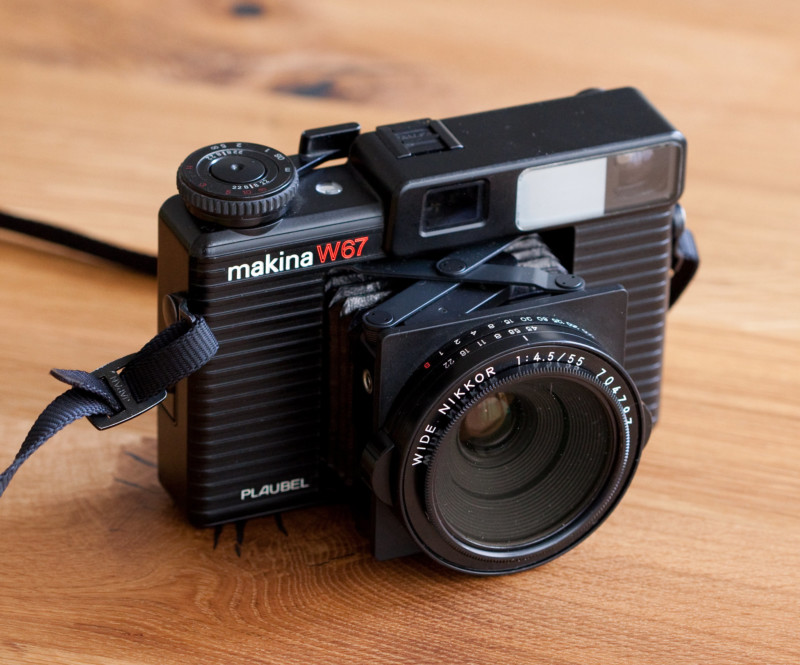
The Plaubel Makina 67 is one of the most valued and desirable medium format bodies ever made. Unlike the more well-known Hasselblads and Mamiyas and Bronicas of the era, the Makina 67 was a rangefinder design, fitted with a Nikkor 80mm f/2.8 lens, integrated light meter, and a bellows extension which kept the camera’s size to a minimum when not in use. The rangefinder approach allowed the camera to remain extremely small and lightweight, despite its large 6×7 capture area.
Introduced in 1978 at Photokina, the Makina 67 was manufactured by Konica/Copal in Japan, though the bellows were made in Germany. This created issues with the production because any pinholes in the bellows would result in light leakage, and any misalignment of tolerances would result in the bellows being unusable.
In stepped Mamiya, who suggested that the parts should not be produced separately — the production of the Makina 67 was then moved to Mamiya in 1981, after which the construction and assembly were significantly more streamlined and effective.
That same year, the Plaubel Makina W67 debuted. It was essentially an identical design as the Makina 67, but with a Nikkor 55mm f/4.5 lens (equivalent to about 28mm in the 35mm format).
The Makina W67 became notable particularly for that lens — it was, and still is, considered one of the sharpest and best lenses ever produced for a medium format camera.
While there were over 15,000 Makina 67 bodies produced, only 3,500 units of the W67 ever saw the light of day. Today, both cameras remain among the most expensive and desirable mass-production medium format cameras ever made — especially the Makina W67.
Rolleiflex 2.8GX Royal Urushi Gold

The Rolleiflex medium format 6×6 TLR (Twin Lens Reflex) cameras are easily the most revered and desirable TLR cameras ever made. Developed to be Rollei’s premier line of medium format cameras, the Rolleiflex line was launched in 1929 with the aptly named Original Rolleiflex. The next model, the Standard Rolleiflex, moved from the very unpopular 117 film used in the Original to 120 film, which of course is still produced today.
There were dozens of models released over nearly nine decades, ending with the Rolleiflex 2.8 FX-N in 2015. In 1981, Rollei became Rollei Fototechnic GmbH after going bankrupt. From then onward, they produced fewer cameras and one of those was the 2.8GX Royal Urushi Gold in 1989. This is not a special edition camera — though it absolutely looks like one — but rather a successor to the Rolleiflex 2.8F with a new Seiko shutter and redesigned light meter.
The most notable thing about the camera is its absolutely gorgeous appearance. Brown African Lizard Skin leather hand-coated with Urushi lacquer adorned its exterior, while most of the metal is coated with 24 karat gold.
Only 130 units were ever made, making it the rarest non-special edition Rolleiflex camera ever produced.
Rollei SL 2000F/3001/3003
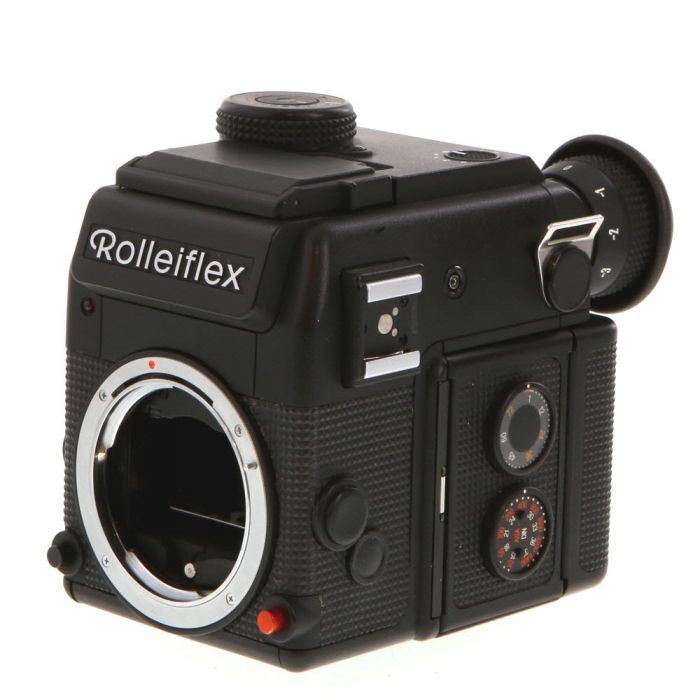
Throughout history, Rollei experienced wild successes — their Rolleiflex and Rolleicord medium format cameras and the Rollei 35 compact cameras. They also experienced significant failures, like their Rolleiflex 35 series of 35mm SLRs, which were fraught with reliability issues.
In 1981, Rollei Fototechnic GmbH & Co. KG released the Rolleiflex SL2000F onto the market, igniting a line of incredibly unique and fascinating cameras. If you knew nothing about the cameras, a simple glance would make you confident that you were looking at a medium format camera. All aspects of the design are standard features of many medium format systems: a waist-level viewfinder, a detachable film back with removable insert, a dark slide, a removable battery pack, an optional pistol grip, and a cube-like form factor. Frankly, the only way you would realize it wasn’t a medium format camera is when you would try to load it up with 120 film and fail.
Among its many innovative and unique features, perhaps the most unique is its integration of both a waist-level finder and eye-level finder into the body — the 3001 model is an exception here, as it was a stripped-down version of the 3003 and did not have the waist level finder. Ironically, it is the rarest of the three models.
Rollei’s lengthy history and collaboration with Zeiss came in quite handy with the cameras — the glass is considered some of the finest ever produced by Zeiss, ranging from a 15/3.5 Distagon to a 1000mm f/8 Tele-Tessar. Rollei also produced their own less expensive line of Rolleinars, from a 14mm f/3.5 to a 500mm f/8 Mirror. Rollei even produced an M42 adapter for Pentax screw mount lenses with full auto-diaphragm capability, which allowed users to adapt the significantly cheaper and highly popular Pentax Takumars.
Unfortunately, the cameras never caught on. There were several reasons for this — size and weight, price, and the emergence and popularity of autofocus in the 1980s, which these lacked. The SL2000F sold 4,800 units, with the 3003 and 3001 selling only 2,800 and 1,600 units, respectively. Today these cameras are considered valuable collector’s items and are uncommon to see — especially since most people have no idea they exist.
Image credits: Header illustration created with still frame from Raiders of the Lost Ark / Lucasfilm Ltd.